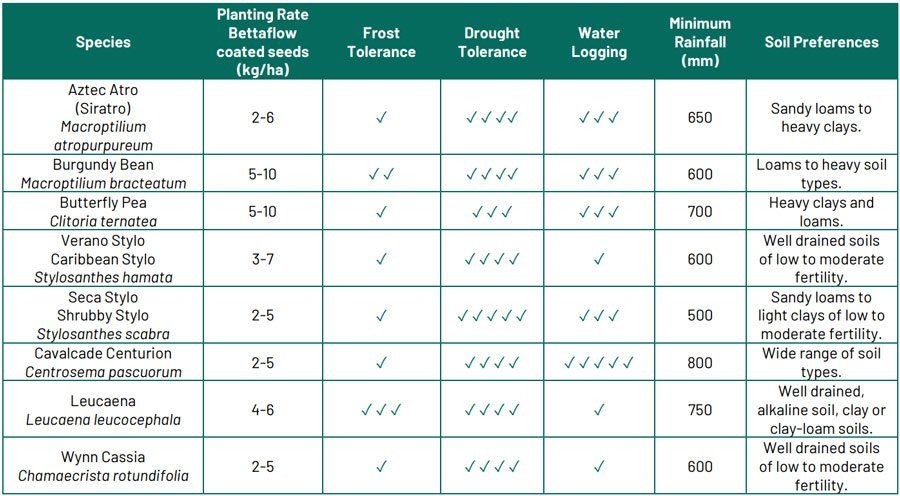Pasture Legumes
Products
Tropical and subtropical legumes
Legumes are popular for their ability to fix atmospheric nitrogen. Legumes come in both temperately adapted and tropically adapted species. Perennial tropical and subtropical legumes are ideal to use in permanent pastures as pure swards or in combination with other grasses. They are also suited as a rotational crop.
Suitable legume selection is dependent on the production system, climate, and physical/chemical soil characteristics. Legumes have different growth habits to grasses. Careful management is needed to maintain over longer time periods.
DASH lablab (Lablab purpureus)
DASH lablab is a fast growing annual, tropical legume. This legume is renowned for high dry matter production. Suited to warmer environments it favours a wide range of soil types.
Aztec Atro Siratro (Macroptilium atropurpureum)
A rust resistant Siratro, but with typical yields 25% higher than Siratro. Vigorous twining, high seed levels. Aztec Atro provides excellent dry matter and plant regeneration. Suited to 750 mm+ rainfall zone.
Wynn Cassia (Chamaecrista rotundifolia)
Adapted to low fertility soils, Wynn Cassia is primarily used in long-term pasture systems to improve pasture composition. Being a prolific seeder, Wynn Cassia can self-regenerate readily. It tolerates heavy grazing and is palatable to cattle during autumn and winter months.
Desmanthus (Desmanthus virgatus)
A highly persistent legume, suited to medium to heavy textured clays with a neutral to alkaline pH. Desmanthus performs well under heavy grazing all season.
Progardes® Desmanthus is a blend of Desmanthus cultivars selected and bred for semi-arid grazing regions with clay-rich neutral to alkaline soils.
Progardes® Desmanthus Fact Sheet
Namoi Vetch (Vicia villosa spp. dasycarpa)
Namoi Vetch is a self-regenerating legume that persists on a wide range of soil types. An annual, growing from autumn to spring, Namoi Vetch is drought tolerate and less likely to cause bloat then other legume alternatives.
Cavalcade Centro (Centrosema pascuorum)
A high-quality forage, Cavalcade Centro tolerates seasonal flooding and is well adapted to fertile soil types. Used in mixed pastures, pure stands and hay, Cavalcade Centro has the potential to produce live weight gains of 460-540 g/day/animal during the dry season.
Cowpea (Vigna unguiculata)
Adapted to a wide range of soil types, Cowpea is an excellent soil conditioner and has a high nutritional value. Cowpea is easily established and drought tolerant, requiring rainfall between 750-1100 mm.
Lucerne (Medicago sativa)
Referred to as the king of forages, Lucerne has a deep penetrating tap root enabling drought resistance. A high-quality fodder, Lucerne is persistent in well-drained soil types.
Arrowleaf clover (Trifolium vesiculosum)
Arrowleaf clover provides good feed over the warmer months. It is suitable for grazing, hay, and silage production. Arrowleaf clover prefers well drained soil types with moderate to high fertility. Primarily used in legume/grass pasture mixes to provide high quality feed in drier conditions. It is self-regenerating and hard seeded, so plant populations are consistent from year to year, providing adequate pasture management.
Butterfly pea (Clitoria ternatea)
Butterfly pea is a fine stem, vigorous legume suited to a wide range of applications including cover cropping, hay production and short or long-term pastures. Butterfly pea is a highly nutritious and palatable feed, liveweight gains of 0.7 – 1.3 kg/day have been recorded.
Burgundy Bean (Macroptilium bracteatum)
Used primarily in short term pasture systems, Burgundy Bean is extremely palatable to stock. Adapted to a wide range of environments, best production is achieved on moderate to heavy clay soil types, with a summer dominant rainfall between 600-1200 mm.
Leucaena (Leucaena leucocephala)
A highly palatable and nutritious stock feed typically grown in Australia to improve live weight gains. Results have shown weight gains of 1.26 kg/day for cattle grazing on a Leucaena and Buffel grass mix.

